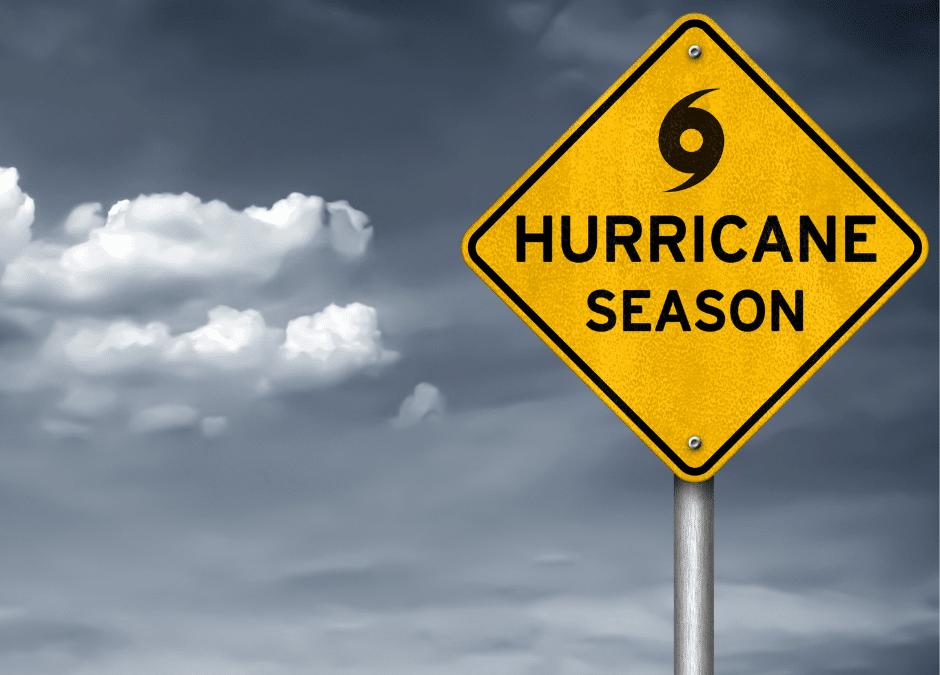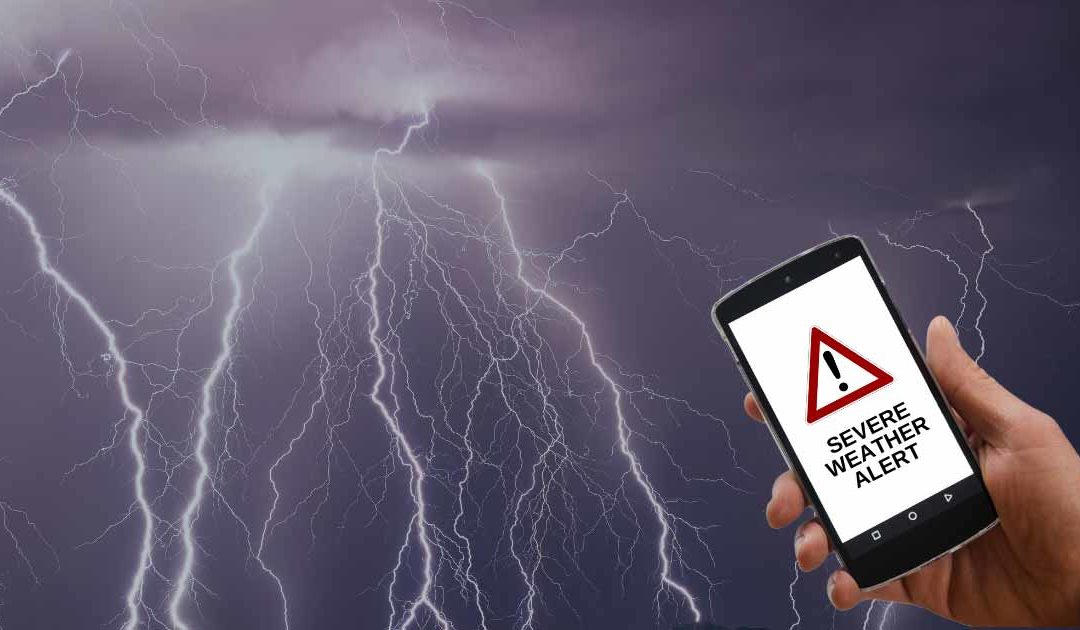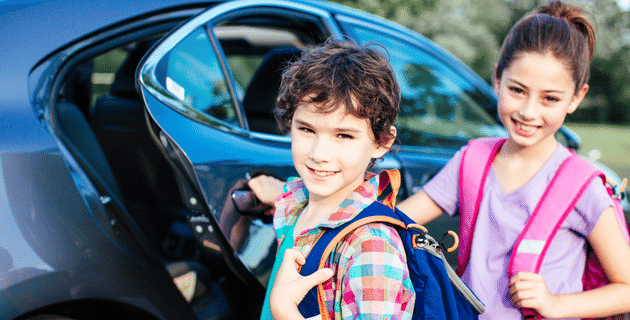
by California Casualty | Homeowners Insurance Info, Safety |
Hurricanes are natural disasters that bring demolishing winds and massive amounts of rainfall to land from the ocean. Coastal towns and cities across the world have been torn apart by hurricanes, but they aren’t the only ones who are usually affected. Hurricanes can cause significant damage to towns over 100 miles inland! September, is the most active month of the year, so now is the time to protect yourself and your family from these deadly natural disasters.
The relative lack of storms so far this hurricane season is bringing both good and bad news. While we are all taking a sigh of relief that there has yet to be a major storm, it could also be bringing a false sense of security. Many people in states where hurricanes usually hit may be “dropping their guard.” A new survey finds only a quarter of those living in hurricane-prone states think they are prepared if a monster storm hits, and nearly half of the respondents say they have yet to make any preparations this year.
Remember all hurricanes, no matter what size, have the potential to cause significant damage and life-threatening situations. Looking back at the destruction previous hurricanes like Harvey, Sandy, and Katrina have caused, it is essential that you make sure your family, home, and belongings are completely protected.
Important Hurricane Coverages:
- Flood Insurance. A regular home insurance policy will not pay for damages caused by flooding, but when you add flood insurance to your policy it will cover all damages that happen to your property, even if you rent! Be aware that when you add flood insurance there is a 30-day waiting period until it goes into effect, so that means it is often too late to purchase it when a hurricane or tropical storm is approaching.
- Scheduled Personal Property Insurance (Floater). Many people find that after a natural disaster their insurance coverage is limited on expensive personal items (ex. jewelry, furniture, technology, firearms, collectibles, furs, instruments, etc.). Floaters protect your personal items for their full value.
Steps to Protect Your Home & Family
- Heed evacuation notices and keep your car’s gas tank full in case of evacuations
- Stock up on essentials like bottled water, non-perishable food items, toilet paper, and pet food
- Make sure pets are kept inside, safe, and have a spot to do their “business”
- Have a family evacuation and communication plan
- Prepare an emergency kit (ex. flashlight, medicines, cash, and important documents)
- Get a NOAA Weather Radio
- Sign up for National Weather Service storm texts at https://www.weather.gov/subscribe-hurricaneinfo
- Charge cell phones and other devices and have charged spare batteries
- Install storm shutters or purchase 5/8 exterior grade or marine plywood to cover windows or doors
- Add straps or additional clips to roofs to reduce damage
- Bring in or secure anything that can be propelled by wind (ex. grills, bicycles, lawn furniture, play equipment, etc.)
- Know how to turn off propane tanks and gas lines
After a Hurricane Strikes
- Make sure you, your family, and pets are safe and secure
- Register yourself as “safe” on the Safe and Well website
- Follow all city boil and curfew orders
- Secure the property from further damage or theft
- Contact your insurance company as soon as possible
- Keep or document receipts and other expenses if you are evacuated or forced to find another place to live because of damage to your home or apartment
- Be wary of unscrupulous contractors following a natural disaster
It’s important to know that flooding and storm surge are the biggest threats to life when hurricanes hit. Leave low-lying areas, never drive or cross through running water, and avoid rivers, streams, and creeks; which could flash-flood.
For more information visit:
https://www.ready.gov/hurricanes
https://mycalcas.com/?s=hurricane
https://www.iii.org/article/preparing-hurricane
https://www.cdc.gov/features/hurricanepreparedness/index.html
https://www.redcross.org/get-help/how-to-prepare-for-emergencies/types-of-emergencies/hurricane.html
This article is furnished by California Casualty, providing auto and home insurance to educators, law enforcement officers, firefighters and nurses. Get a quote at 1.866.704.8614 or www.calcas.com.

by California Casualty | Safety |
Vehicle accidents are the number one cause of death for children between the ages 1 and 4. Your child’s best chance to come out of an accident unscathed is if they are in a car seat that has been installed correctly.
Here are the top car seat safety mistakes.
Price isn’t Everything, Especially when it comes to safety. When it comes to purchasing car seats, the more expensive doesn’t necessarily mean “safer”. There are car seats for every budget. A lot of that extra cost could just be additional features, easy to use, or brand popularity. Find compare and rate car seats using the NHTSA (National Highway Traffic Safety Administration) car seat finder here. So what’s the determining factor on which seat to get? Get the one that has the best rating that fits your budget, vehicle, can be properly installed and used.
Your Child is Too Big for the Seat. You bring your new bundle of joy home in the infant seat, they grow quickly, when do you move up to the next size. Sometimes it might be easy to judge if they outgrow the seat. When they pass the height or weight limits you will need to change seats to accommodate these new changes. You can check the manufacturer’s site for specifics on whether your car seat is still a good fit. Or follow this guide.
Moving to a forward-facing or booster seat too soon. The AAP policy says it’s best to keep kids rear-facing until they turn 2 or meet the maximum height and weight for the seat. Studies say that children under 2 are less likely to be severely injured (or worse) if they are riding rear-facing. Newer car seats are equipped with higher height and weight limits to help encourage rear-facing. But, just because the child meets the minimum weight requirement for a booster seat does not mean they are ready to move up. It comes down to if they can sit correctly in the seat and maintain proper belt positions at all times.
More is not merrier in this case. Do not use both LATCH (Lower Anchors and Tethers for Children) and the safety belt, use the incorrect LATCH anchors, or use a LATCH past its weight limit. What you need to use will depend on your car and the type of seat. One or the other may be the best option, but you shouldn’t need to use both. Double-check your car seat manual to make sure you’re using the correct anchors. You should also note that the lower anchors have weight limits, so you have to switch to vehicle seat belt installation if/when the weight your child + car seat exceeds 65lbs.
Used Seat = Better Deal. Expiration dates, prior accidents, cleanliness- there are all sorts of reasons why to purchase a new seat instead of buying a used one. If you are tight on money, research and see which local organizations offer inexpensive options. You’re carrying precious cargo remember, don’t skip the small stuff!
Taking kids out of car seats too soon. When does a child get to ride like a normal passenger? Great question! When the child can sit all the way back with knees bent over the edge of the seat with their seatbelt properly across the shoulder and the thighs. They need to be able to maintain this position throughout the ride, even if asleep. Check your state requirements, most require the use of a booster through age 8 or 9 (or once they hit a certain height or weight requirement).
Incorrect use of the chest clip. Don’t brush this piece off. It’s actually a crucial feature to the seat, that could end up saving your child’s life. The clip holds the straps so that if an accident happens, the straps will remain secure on the child’s shoulders, allowing full protection from the seat. A clip in the wrong spot could result in ejection, internal injuries, or even death.
Straps need to be snug. One rule to remember: if you can pinch excess strap between your fingers, or if the straps are twisted or gaping, they are too loose. The child’s clothes should never be buckled in while wearing them. You may think it adds “padding” but in an accident, it will compress and leave space that could cause injury.
Wrong harness slot. The manual for the car seat will be specific to your exact seat, but usually, placement depends on the direction the seat is facing. Rear-facing: straps should thread into harness slot at or below the shoulders. Forward-facing: straps should thread into harness slot at or above the shoulders.
It’s ONLY a car seat. Car accidents are the leading cause of death for children. Car seats save lives.
Take the time to properly install your car seat before use and have it inspected by a certified technician for assurance.
Again, your child is precious cargo, take precautionary measures now before you could regret it later.
This article is furnished by California Casualty, providing auto and home insurance to educators, law enforcement officers, firefighters, and nurses. Get a quote at 1.866.704.8614 or www.calcas.com.

by California Casualty | Safety |
Many things in life come without warnings. But fortunately for us, severe weather isn’t one of them.
Meteorologists are constantly tracking dangerous storms and weather patterns. Tapping into their early warnings is key to protecting your home, your possessions, and your family. Here’s what you need to know to stay one step ahead of Mother Nature.
First, let’s take a look at severe weather.
There are many types of severe weather. Examples include thunderstorms, snowstorms, hail storms, blizzards, hurricanes, tornados, and cyclones. High winds and flooding associated with some of these weather events can do great damage to your home and belongings. Having a disaster plan is great, but knowing when disaster is going to strike is crucial. That’s where early warning systems come in.
Chances are you already have an emergency alert system.
The U.S. government has the capability to send wireless emergency alerts (WEAs) right to our cell phones. Agencies like the National Weather Service and FEMA are among the organizations that can do so. There is no signup required and you are not charged for the data used. Alerts come automatically with a special sound and vibration. Most phones are enabled for these alerts; to find out if your particular model is, check the WEA enabled list or contact your wireless carrier.
Check to see that your phone is enabled for alerts.
WEAs may be free but if your phone isn’t enabled to receive them, you won’t. Fortunately, it’s easy to activate this setting.
Apple (IOS) phones
-
- Go to settings, then notifications.
- Scroll down to government alerts.
- Slide the circle so that it is green for the alerts you want. For severe weather, you will want emergency alerts and public safety alerts.
Android phones
-
- Go to apps & notifications.
- Click on notifications.
- Turn on “allow alerts.”
- Make sure each alert that you want is enabled. For severe weather, you will want extreme threats, severe threats, public safety messages, and state and local tests.
While WEAs are good ways to get information, generally these alerts won’t arrive until there is an emergency. You may find value in getting advance notice.
Other ways to get emergency information:
If you do not have a WEA-capable phone, you can still get critical and timely information from NOAA Weather Radio, local media broadcasts, and the emergency alert system on your TV or desktop and mobile devices. Make sure to tune in if you suspect an impending weather emergency. In addition, your local utility company, township, city or state may offer free alerts. Check with your electric or gas company, and with city hall or municipal government. Find out how to sign up for their free alerts.
There’s an app for that, and it’s free.
You can get advance notice and more robust information by downloading a weather app on your smartphone or mobile device. Here are some popular free options.
-
- AccuWeather: Weather Alerts provides hourly forecasts, news, and updates as well as weather-tracking radar.
- AlertSense offers public safety alerts as well as severe weather warnings. You can set quiet hours so only emergency alerts are sent with sound.
- Emergency: Alerts is free from the American Red Cross. With this app, you can look up Red Cross shelters and alert loved ones you are safe. It also comes with a flashlight, a strobe light, an alarm, and preloaded content on everything from hurricanes to disasters that is accessible without an Internet connection
- FEMA offers real-time weather alerts from the National Weather Service for up to five locations of your choice. It also provides information on storm preparedness and filing a flood claim.
- Storm Shield is free with options for paid upgrades. This app provides alerts in text and voice and tracks conditions in up to 5 locations.
- WeatherBug is free with options to purchase in the app. It offers forecasts in real-time as well as weather maps, and more.
- The Weather Channel for Apple or Android offers live radar updates and local weather forecasts.
Stay one step ahead of Mother Nature with coverage from California Casualty.
No matter how well you prepare for severe weather, unfortunately, sometimes Mother Nature gets the upper hand. That’s why having the correct home insurance coverage is so important. Make sure you and your family are fully protected. For questions on home insurance or ways, you can save on your own insurance policy, call a California Casualty agent today at 1.866.704.8614 or visit our website www.calcas.com.
This article is furnished by California Casualty, providing auto and home insurance to educators, law enforcement officers, firefighters, and nurses. Get a quote at 1.866.704.8614 or www.calcas.com.

by California Casualty | Safety |
Football season is finally here! If you’re anxiously getting ready to start the season with some pre-game festivities, there are a few important safety reminders you should brush up on before kickoff. Here’s how you, your friends and family can all tailgate responsibly.
Tip #1: Handle raw meat with care.
You may be known for your spicy chicken wings or beefy burgers but make sure you know the rules for handling raw meat.
-
- Before the tailgate, store meat on the lowest shelf of the refrigerator or in a meat drawer if you have it. Plan to eat or freeze it within 3 to 4 days.
- On tailgate day, store your meat in leakproof plastic bags or containers, with ice in a cooler.
- Wash your hands before and after handling raw meat.
- Wash utensils, cutting boards, and plates that come in contact with raw meat.
- Use separate cutting boards, plates, and utensils for raw meat and for produce.
- Don’t use the marinade from your raw meat on cooked meat. If you want to use it, cook it to a boil first.
Tip #2: Fire up the grill carefully.
Grilling outdoors is a favorite family activity. But injuries from burns or fires can put a real damper on family fun.
-
- Have a fire extinguisher on hand just in case. If you don’t need it, someone else might.
- Enforce a 3-foot “kid-free” zone around the grill. Never leave the grill unattended.
For propane grills:
-
- Be careful not to overfill a propane tank.
- Transport your propane tank safely, so that it is upright and secured in your vehicle.
- Check the connection between the propane tank and the fuel line to make sure there are no leaks. You can do this by making a solution of 50% liquid dish soap and 50% water, and brushing it on the hose connections. If there are leaks, you will see air bubbles when you turn on the propane.
For charcoal grills:
-
- Never add lighter fluid to an already lit fire on a charcoal grill. That can cause the fire to flare up and even ignite the chemical in the can or cause a chemical smog.
- While you can use lighter fluid to start a charcoal grill, consider using rolled-up newspaper instead. Or consider a charcoal chimney, which packs the briquettes together for easier lighting.
- Use plenty of water to douse hot coals after you’re done cooking. Give them a stir to make sure there are no lit embers.
- Do not put the wet coal and embers in plastic, paper, or wooden containers after use. They could still be hot enough to start a fire. Wait until they are completely cool and put them in a coal-safe container to transport them home.
Tip #3: More food safety to keep in mind.
A few hours out in the sun could turn a delicious dish into a potentially hazardous one. Protect your family from food poisoning by following guidelines for food safety.
-
- When grilling, use a food thermometer to check the temperature of your meat. According to gov, chicken should be cooked to an internal temperature of 165°F and ground beef to at least 160°F.
- Nonperishable foods, such as breads, chips, and cookies, can be left out but should be covered for freshness. Condiments like ketchup and mustard are also okay to sit out due to their acid content.
- Perishable foods that typically are refrigerated should not sit out for longer than 2 hours.
- When in doubt, toss it out. If you’re unsure if food is safe to eat, don’t take a chance on it. Throw it out.
Tip #4: Protect yourself from the sun and heat.
Even on a cloudy fall day, you can get sunburned or experience dehydration. Protect yourself and your family.
-
- Wear sunscreen whenever you will be outside for an extended period of time. Reapply every 2 hours.
- Wear sunglasses to protect your eyes and a hat to protect your head from UV rays.
- Find a shaded area near your tailgate to escape the sun and the heat. Or create your own shaded area with a pop-up tent or beach umbrella.
- Alcohol can dehydrate you. It causes your body to remove fluids. Drink water as much as possible and in addition to the alcohol.
- Be aware of the signs of dehydration: muscle cramps, fever/chills, dry mouth/skin, fast heartbeat, confusion, drowsiness, irritability, or a dark urine color. Drinking water is usually the best way to rehydrate.
Tip #5: Appoint a designated driver and drive safely.
Tailgates are all about having a good time, and usually involve alcohol. But drinking impairs driving with sometimes deadly results.
-
- Before you even leave, choose your DD — designated driver – the one who will remain sober. If you have a regular group of friends that tailgate together, you can rotate that duty.
- Better yet, plan to tailgate sober. You can always celebrate after the game, back at home.
- As you search for the perfect tailgate spot, watch for children and adults darting in front of your car. Do the same when you exit after the game.
- Despite your best efforts, accidents can still happen. If you are the victim of a parking lot accident, know your car insurance coverage and alert your insurer as soon as possible.
- If there’s no one who is sober and can drive home, call a cab or ride-share service. It’s far better to get home safely than endanger yourself and others.
Hosting a party instead of tailgating? No worries. Check out our hosting safety guide here.
This article is furnished by California Casualty, providing auto and home insurance to educators, law enforcement officers, firefighters, and nurses. Get a quote at 1.866.704.8614 or www.calcas.com.

by California Casualty | Safety |
When the power goes out and the cell towers go down, do you have a plan? Do your kids and your ex know what that plan is?
Since disaster doesn’t just strike on alternate weekends, it’s important that you take into account both households when you’re a divorced parent. In honor of September, National Preparedness Month, we’ve compiled a list of everything you need to develop a customized plan in the event of a disaster.
Set aside past feelings and connect with your ex.
You fought over who got the widescreen TV; how are you possibly going to agree on where to go and what to do in a crisis? It’s time to set aside your differences and put your children, and safety, first. You will need to communicate during a disaster, and reaching out to prepare for one is a logical first step. Navigate your situation however it is most effective and set up that important first meeting or call to discuss the plan.
Consider your blended/mixed family’s specific needs.
The ages of your children will determine how much assistance they will need, and how much responsibility they may bear. If family members have medical needs, disabilities, or even special dietary restrictions, that has to be taken into account. Pets also need to be accommodated. List each member of your family—human and animal—and any specific needs they may have.
Determine the responsible party.
Children who are in school or daycare will need to be picked up in the event of a disaster. Pets may need to be secured or transported. Designate a responsible party to pick up children and one who will manage pets. It doesn’t have to be you or your ex, but it’s best to choose a trusted individual known to your family. Make sure that the individual is on the approved pick-up list at school or daycare, and has signed up for alerts. Also, make sure that your child knows who is allowed to pick him/her up.
Create an emergency communications plan.
The power may go out; the cell towers may be down. You may not have access to important information during a disaster. That’s why it’s important to create an In Case of Emergency (ICE) card.
-
- List contact information for each member of both families, caregivers, and any other individuals involved in the disaster plan. This includes work phone, home phone, and cell phone numbers.
- Choose an out-of-state contact to call in the event that your state’s phones and resources are down. That person can act as a main point of contact if you can’t reach each other.
- Starting at about age 5, children can learn a phone number. Teach your child one parent’s cell phone number. Try it as a song to the tune of “Twinkle, Twinkle Little Star.”
- Make sure your older children know your cell phone numbers, and don’t just press “mom” or “dad” on their phones.
- If cell phone service is down, advise your children to follow the guidance of trusted adults such as teachers, school administrators, and caregivers. Reassure them that you will be with them as soon as possible.
- Consider a prepaid phone card for use in an emergency.
Choose an emergency meeting place.
Depending upon the emergency, your home may not be the safest place to take shelter. If that is the case, you will want to choose a place in your neighborhood to meet. The local park, the school, the library, or your place of worship are all familiar and trusted options. If you are able to meet at home, make that the first choice—but be sure to determine whose home it is.
Pack a grab-and-go bag or emergency kit.
If you have to leave suddenly, there’s little time to pack. Having a grab-and-go bag or an emergency kit helps make sure you have everything you need. Pack a bag for every member of your family, including your pets. Include supplies for 3 days: a change of clothes, food, water, medications, hand sanitizer, blankets, etc. You will want a bag at each household, as you don’t know where the children will be when disaster strikes. Also, since children grow, and needs change, make sure you check your emergency kits every three months and update them as needed.
The type of disaster matters.
Severe weather is not the same as an earthquake or a fire. Have a plan for the different types of disasters that may affect your area. For example:
-
- In a hurricane, tornado, or high-wind storm, stay inside your home. Choose a small, interior room without windows, such as a bathroom or closet, on the first level.
- In a fire or evacuation, you may need to leave your home suddenly. If you need to meet, choose a spot in your neighborhood such as a playground, a big tree, or distinctive mailbox.
- In the event of an emergency, make sure the lines of communication are open between you and your ex. Have a plan in place to notify that the children are safe.
Practice, practice, practice.
Make an ICE card with the basics of the plan (including contacts) that can be kept in each adult’s wallet. Include a copy in your school-age child’s backpack. Then, schedule some time to practice the plan with your children. Practice different kinds of emergencies with each parent.
There’s an app for that.
There also are apps that you can use to prepare for an emergency. FEMA offers interactive checklists and emergency safety tips. The Red Cross provides apps specific to hurricanes, tornados, and earthquakes. Plus, the government has some great resources for disaster planning, including games kids can play to get ready.
This article is furnished by California Casualty, providing auto and home insurance to educators, law enforcement officers, firefighters, and nurses. Get a quote at 1.866.704.8614 or www.calcas.com.

by California Casualty | Educators, Safety, Travel |
Back-to-school means back to hectic schedules. Between sports, clubs, and other after-school events it feels like you are being pulled in all directions. Considering that other parents are making the same hectic trek, there’s an opportunity to lighten the load. Carpooling.
Not only can carpooling free up your schedule, but it can also help you save on gas. (Definitely a bonus!) Follow these tips to set up your carpool experience for success.
1. Find your carpool buddies.
It’s best to carpool within a trusted network of fellow parents. Don’t worry about coordinating around age or gender. The goal is to make your life easier and not simply offer car time for your child and his bestie.
That being said, start with your child’s friend group and see who might be joining the same activities. If they live nearby, that could be a match. Otherwise, ask the coach or coordinator for a parent contact list and reach out to those who live close to you. Also talk to parents at activity pickup, at school PTO meetings, or at your local religious services. Even friends of friends might be good carpool candidates.
Pro Tip: Pick the right number of kids for your carpool. Younger children need more attention and so their carpools should be smaller.
2. Set the schedule.
It’s important to make a set schedule so that kids aren’t left waiting. Using a carpool app can help you organize, and some apps even come with reminders. Some popular apps include Carpool-kids, Waze Carpool, and GoKid. You can even use Signup Genius or Google sheets. (If you use Google, you will want to download the sheets app to your smartphone.) You also can do an email or text chain.
Choose the system that works for your group and make sure everyone is comfortable with it. Also, it’s important to make sure you can communicate with other parents in the case of an emergency, accident, sickness, or unexpected change of plans. (Anyone who has forgotten an early dismissal day knows the importance of communication.)
Pro Tip: Post a copy of the carpool schedule near the door and include it in your child’s backpack. This way, he or she knows who is picking up.
3. Set expectations.
If possible, schedule an in-person meeting with your carpool participants. Not only does it make it easier to create the schedule, it helps you come to an agreement on rules and expectations. For example, how many minutes late is too late? What is the policy if you’re picking up a child who is not ready? Verify schedules and conflicts. Determine food allergies if any. Inquire about health-related concerns.
Pro Tip: Important point for discussion: Don’t let anyone outside of the carpool cover the route (e.g. babysitter, grandma) unless every parent is aware and agrees.
4. Stay safe.
Don’t forget to discuss the safety rules. For example, children must enter and exit the vehicle from the curbside. Only kids who are 13 and older may ride in the front passenger seat. Students who do not meet the necessary height and weight requirements must ride in a booster seat.
For carpools, consider harness-style options that move the seatbelt down, rather than boost the child up, such as the WhizRider. These lightweight accessories can travel with your child and fit right in their backpack for easy access for carpooling.
5. Do a practice run.
You know the route to your child’s activities but you may not be familiar with the addresses where you are dropping your carpool kids. Do a practice run with the kids. Take a trip to the local ice cream parlor or head to the library. This will help you to work out any issues before you start.
6. Bring snacks.
If you’re shuttling kids from school to after-school activities, snacks and drinks are a must. Even if you’re just taking them home, you’ll find that food and drinks help to keep them happy. Greet kids with healthy portable snacks that don’t create too much mess. Chilled water in reusable bottles make a great choice because if they’re spilled, there won’t be too much mess. Keep any food allergies in mind when selecting snacks; alternatively, you can ask parents to pack their own child’s treat.
Pro Tip: Have a cleanup pack on hand that includes paper towels and baby wipes. Put a trash bag in the backseat where the kids can put their trash.
7. Don’t forget entertainment.
Even a short car ride can be made more enjoyable when the occupants are entertained. This may include car karaoke with their favorite songs or taking turns reading aloud from a joke book. You also may want to provide games with magnetic pieces. Just make sure you have a place to store them, such as with a backseat organizer. For older kids with different musical preferences, headphones work well as they listen or watch on their devices. Finally, if you’re going to be waiting in the car, keep the things that entertain you. Bring a favorite book, a relaxing playlist, and a charger, and enjoy some much-deserved quiet time.
8. Check in with your child.
Things may be going well on your end, but you don’t know what happens when the other parents are driving. Check-in periodically with your child. Get his or her perspective on the carpool, and make adjustments as needed. It’s also a chance to determine if you need to rethink participating in a carpool.
Finally, if you’re transporting precious cargo, you’ll want to ensure that your vehicle is carpool ready. Keep your car well maintained. Protect your vehicle with the right insurance for peace of mind.
Safe travels.
This article is furnished by California Casualty, providing auto and home insurance to educators, law enforcement officers, firefighters, and nurses. Get a quote at 1.866.704.8614 or www.calcas.com.






